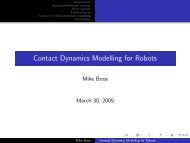Kinematic Model of a Piano Action Mechanism c Martin Hirschkorn ...
Kinematic Model of a Piano Action Mechanism c Martin Hirschkorn ...
Kinematic Model of a Piano Action Mechanism c Martin Hirschkorn ...
Create successful ePaper yourself
Turn your PDF publications into a flip-book with our unique Google optimized e-Paper software.
<strong>Kinematic</strong> <strong>Model</strong> <strong>of</strong> a <strong>Piano</strong> <strong>Action</strong> <strong>Mechanism</strong><br />
c○ <strong>Martin</strong> <strong>Hirschkorn</strong> Stephen Birkett John McPhee<br />
Systems Design Engineering, University <strong>of</strong> Waterloo, Ontario, Canada<br />
1. INTRODUCTION<br />
A modern piano action is a complex mechanism <strong>of</strong> wood,<br />
metal, and cloth (felt and leather) components that transfer<br />
forces applied by a pianist into a hammer motion that<br />
excites the string. In practice, an action must have an escapement<br />
system to allow the hammer to be free <strong>of</strong> the<br />
mechanism during the period <strong>of</strong> impact with the string, preventing<br />
blocking and the damping effect that this causes.<br />
In addition, a system to catch the hammer and allow rapid<br />
repetition is usually included. These two complexities may<br />
be disregarded when considering just the basic operation<br />
<strong>of</strong> the mechanism, which in essence is simply a system <strong>of</strong><br />
three levers in series providing a rapid acceleration <strong>of</strong> the<br />
hammer from a small motion <strong>of</strong> the key.<br />
Due to the difficulties arising from the non-linearities in<br />
the piano action dynamics, theoretical investigations initially<br />
focused on the kinematics [1]. More recent work has<br />
been able to incorporate some dynamic effects [2, 3]; in<br />
these models however, component parts are treated as rigid<br />
bodies, to simplify the mathematical representation, and action<br />
response is related only to the motion <strong>of</strong> these components<br />
in response to ideal, frictionless, mechanical linkages.<br />
Experimental investigations <strong>of</strong> action behaviour have been<br />
quite comprehensive [4, 5, 6, 7].<br />
Despite the importance <strong>of</strong> dynamic effects, useful results<br />
can be obtained from a study <strong>of</strong> the kinematics alone [8].<br />
This article presents a kinematic model <strong>of</strong> the (simplified)<br />
modern piano action and illustrates how non-trivial conclusions<br />
may be derived.<br />
2. SYSTEM MODELLING<br />
The basic action model consists <strong>of</strong> three components: the<br />
key, whippen/jack, and hammer, as shown in Figure 1. By<br />
ignoring the repetition mechanism, the whippen and jack<br />
have a fixed relationship and may be regarded as a single<br />
rigid body. When depressed, the key pivots about a point<br />
at A and, through the capstan connection, causes the whippen/jack<br />
to pivot about B. Through the knuckle connection,<br />
this causes the hammer to rotate about its pivot point C.<br />
Hammer<br />
B<br />
Capstan<br />
Knuckle<br />
C<br />
Repetition Assembly<br />
Jack<br />
Whippen Key<br />
A<br />
Figure 1. Schematic model <strong>of</strong> a piano action<br />
All three pivot points, A, B, and C, are treated as ideal<br />
revolute joints. The connections at the capstan and the<br />
knuckle are sliding contact surfaces, modelled as prismatic<br />
and revolute joints in series. This simplified action can be<br />
seen in Figure 2.<br />
Hammer<br />
B<br />
w<br />
S 2<br />
Whippen/Jack<br />
S 1<br />
C<br />
A<br />
h<br />
k<br />
Key<br />
Figure 2. Simplified schematic <strong>of</strong> a piano action<br />
A graph-theoretic approach [9] was used to automatically<br />
generate the closure conditions around the two independent<br />
kinematic loops. The result is a set <strong>of</strong> four nonlinear algebraic<br />
equations for the kinematics:<br />
L 2 C θk − L 3 C θw − L 4 S θw S 1 S θk − L 1 =0 (1)<br />
L 2 S θk − L 3 S θw + L 4 C θw + S 1 C θk − L 5 =0 (2)<br />
L 8 C θh − L 7 S θw + L 9 S θh + S 2 C θw − L 6 =0 (3)<br />
L 8 S θh + L 7 C θw − L 9 C θh + S 2 S θw + L 10 =0 (4)<br />
in which L 1 −L 10 are constants related to the dimensions <strong>of</strong><br />
the components, S θk , C θk , S θw , C θw , S θh , and C θh are the<br />
sines and cosines <strong>of</strong> the rotation angles <strong>of</strong> the key, whippen,<br />
and hammer, respectively, and S 1 and S 2 are the displacements<br />
<strong>of</strong> the two prismatic joints, as shown in Figure 2.<br />
Thus, five variables appear in these four equations, as<br />
expected for a system with one degree <strong>of</strong> freedom. By prescribing<br />
a range <strong>of</strong> values for the key angle θ k , these nonlinear<br />
kinematic equations were solved using the Newton-<br />
Raphson method. Time was not considered in this analysis;<br />
instead, the relative positions <strong>of</strong> the components were determined<br />
for a given position <strong>of</strong> the key front (mm) below<br />
its rest position, which was easily calculated from θ k .<br />
3. RESULTS AND DISCUSSION<br />
One measurement that is <strong>of</strong> interest to piano designers is the<br />
extent <strong>of</strong> sliding between the contact surfaces at the capstan<br />
and knuckle. More sliding increases the wear <strong>of</strong> the components<br />
and reduces the efficiency <strong>of</strong> the action, due to the<br />
friction between the sliding surfaces. A plot <strong>of</strong> the relative
movement between the two contact surfaces can be seen in<br />
Figure 3.<br />
Relative Sliding (mm)<br />
2<br />
1.8<br />
1.6<br />
1.4<br />
1.2<br />
1<br />
0.8<br />
0.6<br />
0.4<br />
0.2<br />
0<br />
Capstan<br />
Knuckle<br />
0 2 4 6 8 10<br />
Key Position (mm)<br />
Figure 3. Relative sliding between components<br />
There is very little sliding occurring at the capstan. While<br />
the point <strong>of</strong> contact between the key and whippen changes,<br />
the bodies are mostly rolling against each other, not sliding.<br />
Substantially more sliding occurs between the jack and<br />
hammer at the knuckle.<br />
Another interesting measure that can easily be obtained<br />
from the model is the instantaneous effective leverage ratio<br />
<strong>of</strong> the action. Leverage ratio is defined as the ratio <strong>of</strong><br />
the speed <strong>of</strong> the hammer to the speed <strong>of</strong> the key. This was<br />
approximated by calculating the ratio <strong>of</strong> the distance travelled<br />
by the hammer head and key front for each step <strong>of</strong> the<br />
solution.<br />
In an effort to improve the response <strong>of</strong> a piano key, the<br />
geometry <strong>of</strong> the action might be changed by moving the<br />
capstan or the knuckle. Figure 4 shows the results <strong>of</strong> these<br />
changes, in which the kinematic equations were solved for<br />
three cases: (i) no change to capstan or knuckle; (ii) capstan<br />
shifted 10mm closer to the key front; and (iii) knuckle<br />
shifted 3mm closer to the pivot C.<br />
Leverage Ratio<br />
8<br />
7<br />
6<br />
5<br />
4<br />
3<br />
2<br />
1<br />
0<br />
Normal<br />
Shifted Capstan<br />
Shifted Knuckle<br />
0 2 4 6 8 10 12<br />
Key Position (mm)<br />
Figure 4. Leverage ratios<br />
In all cases the leverage ratio decreases through the key<br />
stroke, meaning the key must be accelerated in order to<br />
maintain the same hammer speed.<br />
Moving the capstan causes a significant decrease in the<br />
leverage ratio, resulting in a less responsive action and<br />
slower hammer speed. Shifting the knuckle increases the<br />
leverage ratio, which results in a higher hammer speed.<br />
4. CONCLUSIONS AND FUTURE RESEARCH<br />
Even with the simplified model used here, it is possible to<br />
obtain interesting results. With this information, a piano<br />
designer can determine where some <strong>of</strong> the frictional losses<br />
are occurring in the action, and quickly check how modifications<br />
to the design affect the relative motions <strong>of</strong> the components.<br />
A more complex model could be obtained by representing<br />
some <strong>of</strong> the important dynamic effects. This would allow<br />
forces in the joints and between the contact surfaces,<br />
as well as component accelerations, to be calculated from a<br />
specified force input at the key.<br />
In addition, the complexity <strong>of</strong> the component models<br />
could be increased by replacing the simplified ideal revolute<br />
joints with more realistic felt bushings, or using flexible<br />
beam models instead <strong>of</strong> some <strong>of</strong> the rigid bodies. The<br />
contact surfaces are currently modelled as ideal prismatic<br />
joints, but in reality they are contacts between rigid surfaces<br />
and cloth materials, for example wood and leather,<br />
or brass and felt. To account for the nonlinear, hysteretic<br />
nature <strong>of</strong> felt and leather, a more realistic contact dynamic<br />
model [10] could be incorporated.<br />
REFERENCES<br />
[1] W. Pfeiffer: The <strong>Piano</strong> Key and Whippen, Verlag Das<br />
Musikinstrument, Frankfurt, 1955, English transl. J.<br />
Engelhardt (1965).<br />
[2] A. Oledzki: “Dynamics <strong>of</strong> piano mechanisms”, Mech.<br />
and Machine Theory 7, 373-385 (1972).<br />
[3] B. Gillespie and M. Cutkosky: “Dynamical <strong>Model</strong>ing<br />
<strong>of</strong> the Grand <strong>Piano</strong> <strong>Action</strong>”, Proc. <strong>of</strong> the International<br />
Computer Music Conference, San Jose, CA,<br />
77-80 (1992).<br />
[4] A. Askenfelt and E.V. Jansson: “From touch to string<br />
vibrations. I: Timing in the grand piano action”, J.<br />
Acoust. Soc. Amer. 88, 52-63 (1990).<br />
[5] A. Askenfelt and E.V. Jansson: “From touch to string<br />
vibrations. II: The motion <strong>of</strong> the key and hammer”, J.<br />
Acoust. Soc. Amer. 90, 2383-2393 (1991).<br />
[6] H.A. Conklin: “Design and tone in the mechanoacoustic<br />
piano. Part I. <strong>Piano</strong> hammers and tonal effects”,<br />
J. Acoust. Soc. Amer. 99, 3286-3296 (1996).<br />
[7] E. Hayashi, M. Yamane and H. Mori: “Behavior<br />
<strong>of</strong> piano-action in a grand piano. I. Analysis <strong>of</strong> the<br />
morion <strong>of</strong> the hammer prior to string contact”, J.<br />
Acoust. Soc. Amer. 105, 3534-3544 (1999).<br />
[8] R. Overs: “Design <strong>of</strong> the Overs action”, <strong>Piano</strong><br />
Technicians Guild, Annual Conference, Reno,<br />
http://overspianos.com.au/rno2001.html (2001).<br />
[9] P. Shi and J. McPhee, “Dynamics <strong>of</strong> flexible multibody<br />
systems using virtual work and linear graph theory”,<br />
Multibody System Dynamics 4, 355-381 (2000).<br />
[10] Y. Gonthier, J. McPhee, J.-C. Piedboeuf, and C.<br />
Lange, “A regularized contact model with asymmetric<br />
damping and dwell-time dependent friction”, Multibody<br />
System Dynamics (2002).











